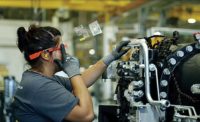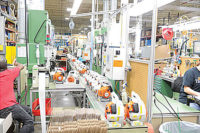This month marks the 100th anniversary of the world's first powered flight. In 1903, Orville and Wilbur Wright were obscure bicycle mechanics in Dayton, OH, who assembled a fragile aeroplane out of wood, wire and fabric after several years of exhaustive research.
Despite sending inquisitive letters to leading internal combustion engine manufacturers around the world, the Wright brothers received few replies. In fact, some of the responses were rude and insulting. With the help of a machinist friend, Charlie Taylor, the brothers developed a four-cylinder, 12-hp engine and bolted it to the airframe. To reduce weight, the homebuilt 179-pound engine featured a crankcase and water jacket formed as a one-piece aluminum casting.
On Dec. 17, 1903, the biwinged machine flew for 12 seconds over a distance of 120 feet on a windswept beach in Kitty Hawk, NC. The historic event ushered in a new era that revolutionized commerce and transportation. In less than 40 years, airplanes evolved from open-cockpit biplanes with wood fuselages and cloth-covered wings to streamlined aluminum monoplanes.
There was widespread public interest in flying in the early 20th century, but aircraft production did not develop quickly in the United States. The Wrights didn't even establish a factory until six years after their historic flight. In fact, by 1911, "France was generally regarded as the leading aeronautical nation, both in design and production," says Donald Pattillo, author of Pushing the Envelope (University of Michigan Press). "The first aircraft company in the world was that of the Voisin brothers of France, whose factory began production in 1907."
The U.S. aircraft industry evolved slowly. According to Pattillo, "it was not until 1914 that any manufacturer received an order for more than six airplanes at a time. Claiming to be an aircraft manufacturer was relatively easy, but it was quite a different task to sustain production in the field."
By 1914, the Curtiss Aeroplane Co. (Hammondsport, NY) surpassed the Dayton-based Wright Co. and became the largest aircraft manufacturer in the United States. Between 1916 and 1918, it assembled more than 5,000 JN-4 "Jenny" aircraft for military applications during World War I.
The war had a major effect on the aviation industry. Aircraft production in the United States mushroomed from 411 units in 1916 to 2,148 units in 1917, as manufacturers learned how to assemble large numbers of standardized products, such as Liberty engines.
Many automakers, such as Ford, General Motors and Packard, assembled engines and aircraft during the war. However, "the mass production techniques used in the auto industry were not readily adaptable to aircraft," says Pattillo.
Assembling aircraft was a labor-intensive job. Processes such as attaching wire rigging demanded a high level of skill and were very time-consuming. "Aircraft production at the time, with its use of formed wood and wire, was more comparable to the manufacture of pianos than of automobiles," Pattillo points out.
At the end of World War I, aircraft production dropped from a high of 14,020 units in 1918 to only 328 units in 1920. The market was saturated with surplus war aircraft. Many manufacturers closed their plants and total employment in the U.S. aviation industry was only 4,000, compared to 175,000 during the war. Some companies were forced to manufacture other products to make ends meet. For instance, the Boeing Co. (Seattle) assembled wooden bedroom furniture and speedboats.
In 1923, the year when the original Wright patents expired, only 743 aircraft were assembled in the United States. To maintain "continuity of production," the federal government stepped in and began to develop a national aviation policy.
Passage of the Air Mail Act of 1925 spurred the development of new aircraft, new materials and new manufacturing techniques. For instance, between 1926 and 1928, total U.S. aircraft production grew from 1,186 to 4,346 planes, and the value of civilian aircraft sold exceeded military aircraft for the first time.
When Boeing received a government contract to mass-produce DH-4 biplanes-the main aircraft used for airmail service in the late 1920s-it was forced to explore new assembly processes. "To speed up the fuselage manufacturing, Boeing developed an arc-welding process to join the complex tubing rather than using the slower gas-welding alternative," says Guy Norris, author of Boeing (MBI Publishing Co.). "This advanced, electrically based process laid the foundation for mass-production techniques that would become vital to Boeing's efficiency in future years."
Wood vs. Metal
Most of the aircraft built during World War I were constructed with wood. Early aircraft fuselages were assembled using monocoque structures. Wooden hoops were shaped over a curved form and then glued. Often, braces ran the length of the fuselage. Strips of plywood were glued over the framework.
In 1918, Jack Northrop devised a new way to construct a monocoque fuselage. He used two molded plywood half-shells that were glued together around wooden hoops or stringers. To construct the half shells, three sets of spruce strips were soaked with glue and laid in a semicircular concrete mold. This revolutionary process reduced production time from several days to less than 30 minutes.
Under a tightly clamped lid, a rubber balloon was inflated in the cavity to press the plywood against the mold. Twenty-four hours later, the smooth half-shell was ready to be joined to another to create the fuselage. The two half shells were each less than 0.25-inch thick.
Other manufacturers experimented with truss structures. During the war, German engineers successfully mass-produced metal aircraft, such as the Junkers J 1. The pioneering planes were immediately popular because of their strength and armor protection.
In 1920, the National Advisory Committee on Aeronautics (NACA) declared that metal was superior to wood because it "does not splinter, is more homogeneous and the properties of the material are much better known and can be relied upon. Metal also can be produced in large quantities."
Edward Warner, a professor of aeronautics at the Massachusetts Institute of Technology (Cambridge, MA), authored a landmark paper in 1922 entitled "Metal Construction of Aircraft." Warner claimed that "the future belongs largely, if not solely, to metal construction" because "its practicability has been demonstrated beyond question."
Warner pointed out that steel "has the merit of being weldable . . . and joints can be quickly, cheaply and neatly made by that method, where riveting would have to be employed in connection with aluminum. The aluminum alloys, on the other hand, are soft and easy to work and their lightness makes it possible to employ much thicker sections than could be used in corresponding members made of steel.
"The only thing that keeps metal from more extended use is the preliminary expense, which imposes an intolerable overhead," added Warner. "The making of metal spars, for example, requires a preliminary equipment of dies and rolls and special tools which is far beyond that necessary for wooden construction. Metal airplanes cannot be built cheaply, and therefore will not be built commonly until the public interest in aeronautics is aroused to such a point that the demand justifies the production of airplanes in considerable quantities. When that time comes we may expect to see wood largely disappear, as it has already done is special experimental airplanes."
The U.S. Navy developed duralumin fabrication techniques at its Naval Aircraft Factory in Philadelphia. However, this material had severe corrosion problems and turned brittle. Duralumin, an aluminum-copper alloy, weakened internally and could fail suddenly in flight.
Despite those disadvantages, some manufacturers continued to develop metal designs. The first all-metal commercial airplane, the Pullman, was unveiled by Stout Metal Airplane Co. (Detroit) in 1924. The high-wing monoplane could carry eight passengers.
In 1925, Henry Ford acquired Stout and developed the 4-AT trimotor, which featured corrugated metal construction. It used a new alloy called Alclad, which combined the corrosion resistance of aluminum with the strength of duralumin.
The Aluminum Co. of America (Alcoa, Pittsburgh) unveiled Alclad in 1927. It consisted of an aluminum alloy bonded to pure aluminum. It solved many of the corrosion problems of duralumin and spurred the development of metal aircraft.
Assembly Challenges
Manufacturers continued to experiment with new assembly techniques. For instance, when Boeing built the P-12/F4B for military applications in the late 1920s, wood was replaced by metal framing. Engineers also took the extra step of replacing welded steel with bolted aluminum to save weight.
Many engineers believed that metal offered significant advantages over wood. However, wood was still lighweight and easy to work with. Plywood skin could be easily shaped to form a smooth surface.
Engineers had a difficult time developing metal wings and airframes that weighed as little as wood. By 1929, metal wings still weighed 25 to 36 percent more than wood wings. And, a decade after NACA had declared metal superior to wood, only 5 percent of the aircraft in production were of all-metal construction.
One of the big problems with metal was that it buckled when compressed. Unfortunately, stressed-skin structures made this problem more acute. To combat the problems associated with compressive buckling, metal structures required complex curves. In addition, unique riveting and reinforcement requirements increased production costs.
It took a tragic event to totally convert the industry from wood to metal. In 1931, seven people, including legendary college football coach Knute Rocke, were killed in a plane crash in Kansas. A widely publicized investigation revealed that the Fokker F-10A trimotor plane's wooden wing had rotted away where it joined the fuselage.
By the mid-1930s, wood was no longer used on American multiengine passenger aircraft. For instance, when Douglas Aircraft Co. (Santa Monica, CA) unveiled its revolutionary DC-1 twin-engine model in 1933, it featured an all-metal, stressed-skin semimonocoque fuselage backed by aluminum alloy stiffeners. In 1934, Lockheed Aircraft Co. (Burbank, CA) introduced the trend-setting Model 10-A Electra, which was built entirely of light aluminum alloy. It featured a monocoque fuselage and cantilever wings, making it light yet strong, and free from the drag-inducing struts and bracing wires of earlier aircraft.
The year 1938 marked a milestone in the U.S. aircraft industry. With sales of only $131 million, aviation was overshadowed by the bicycle industry. But, Patillo says that was the last year that aircraft manufacturing would be considered a "small" business.
World War II transformed the industry. "The limited production capacity of the prewar industry soon was exceeded by war requirements," says Pattillo. "Before 1940, a production order for 100 aircraft would have been considered major. As in the first world war, the automobile industry and related industries would become directly involved in aircraft production."
Because of new materials, tools and processes developed in the 1930s, production volume soared to unprecedented levels. For example, 26,289 aircraft were assembled in 1941, compared to only 3,623 in 1938. By 1944, more than 95,000 aircraft were manufactured in American factories. When Orville Wright passed away in 1948, the jet age had just begun and the industry that he and his late brother pioneered 45 years earlier was a key part of the U.S. economy.


